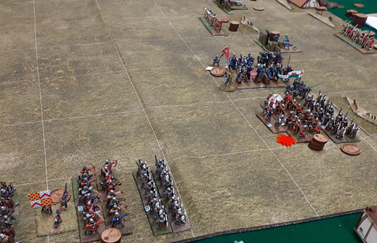The sixth
game in our Wars of the Roses campaign was the battle of Mortimer Cross between
the Yorkist Earl of March (David) and the Lancastrian Duke of Somerset (Rick).
At Mortimers Cross both armies were mostly made up of new recruits although the Lancastrians were stiffened by a contingent of Welsh mercenaries.
The battlefield was
generally flat and featureless with a large marsh dominating the the centre of
the Northern board edge. Tucked away in
the extreme North East of the field was the tiny village of Kingsland.
David decided to set up on the
South side of the battlefield. He
started his deployment, by placing his artillery in a palisaded position on his
left centre, creating a large swept area to their front. The guns were
supported by units of longbows under the command of Baron Bonville (David).
The Lancastrians responded with a
mixed force of bills and bows on their right flank under the command of Baron
Hungerford (Adrian).
David then completed the deployment
of his centre placing a strong force of bills to the right of his artillery
park commanded by Baron Fauconberg (Paul).
Rick then set up his centre under his personal command. Dismounted Men at arms bills and archers were deployed in his left centre denying David’s artillery any easy targets.
David deployed his right flank consisting of archers backed up by a single unit of bills and his remaining Burgundian handgunners commanded by Baron Scrope (Tony).
Rick responded by deploying his mailed fist, placing his cavalry on his left under the command of the Earl of Wiltshire (Reg).
The Lancastrians planned to avoid the Yorkist artillery and effect a double envelopment, smashing the Yorkist right with armoured knights and engaging the Yorkist left with billmen closely supported by longbow fire.
The Yorkists were deployed to meet
the advancing Lancastrians with artillery and bow fire supported by a reserve
of bills and mounted knights.
Having won the scouting the Lancastrians began the battle with rapid advances on both wings.
Alarmed at the rapid advance of the
Earl of Wiltshire (Reg) the Yorkist right (Tony) responded by extending his
Burgundian handgunners to the right to meet the advancing Earl’s bodyguard. Yorkist defensive longbow fire succeeded in
disordering the main body of Lancastrian knights.
Lord Fauconberg (Paul) also moved his troops to the right in support of their right wing driving back the disordered Lancastrian knights.
On the Yorkist left the earl of March led his knights forward into the centre of the battlefield
Both Lancastrian wings continued to advance. On their left the Earl of Wiltshire (Reg) drove the Burgundians from the table. On their right Baron Hungerford’s (Adrian’s) bills and longbows threatened the exposed Yorkist camp.
Recognising the threat to his camp the Earl of March (David) turned his knights left and engaged Lord Hungerford’s (Adrian’s) advancing infantry disordering them and lightly wounding the Baron.
On the Lancastrian left (Reg) their retreating and disordered knights failed to rally. To make things worse the Lancastrian Currors were also thrown into disorder by fierce Yorkist longbow fire. The Duke of Somerset (Rick) began to move his centre in support of his faltering left, presenting a target of opportunity to the Yorkist bombards.
Baron Scrope (Tony) continued to press his advantage destroying the Lancastrian Currours and turning his archers to their right to menace the flank of the Lancastrian Northern Border Staves.
On the Lancastrian right flank Baron Hungerford (Adrian) continued to push his infantry forward advancing the main body of his infantry and turning his lead units to face the Earl of March’s (David’s) knights.
The Earl of March (David) countered by expanded his front to protect the flank of his engaged knights and threatening the exposed flank of Adrian’s advancing infantry. A desperate battle developed between the Yorkist Knights and Baron Hungerford’s bills.
Back on the Lancastrian left the
Earl of Wiltshire (Reg) now began to move against the rear of the Yorkist
line. The Northern Border Staves
turned to face the threat to their right and Reg’s bodyguard struck against Scrope’s
(Tony’s) longbows on the end of the Yorkist line destroying them.
Seeing an opportunity to outflank the Lancastrian bodyguard Scrope (Tony) about faced his bills and moved against the exposed flank of the Lancastrian bodyguard destroying them.
The Earl of Wiltshire’s (Reg’s) Lancastrian light horse now charged into the exposed flank of Scrope’s (Tony’s) bills destroying them and continuing on to destroy the archers beyond them. Baron Scrope himself was lightly wounded and moved to join his handgunners bringing them back onto the battlefield.
Perfidious Lancastrian spies now sowed confusion and dissension amongst Baron Fauconberg’s bills, causing them to about face and present their rear to the enemy.
On the Yorkist left the struggle between The Earl of March (David) and Lord Hungerford’s bills (Adrian)resolved itself in the destruction of the Yorkist knights.
Pressing forward Adrian’s bills were sent directly to hell by the flame and iron of the Yorkist bombards.
On both flanks the Lancastrians refused to accept defeat. On their left the Earl of March (David) withdrew his bodyguard before launching yet another charge against Baron Hungerford’s leading Lancastrian archers.
On the right Fauconberg’s (Paul’s) bills pushed back the rampaging Lancastrian light cavalry.
With the Yorkist right wing shattered, their centre (Paul) struggling to present a united front against the advancing Duke of Somerset (Rick) and their left wing (David) consisting of the Earl of March and his body guard facing off against three Lancastrian units (Adrian), the battle was declared a Lancastrian victory.
The next battle will be 2nd St. Albans between Richard Neville the Earl of Warwick (Paul) and Henry Percy Duke of Northumberland (Doug/Reg)tentatively scheduled for 12th December. Paul, Reg, Doug will that be ok?
This will be the first of the
historical grudge matches so each unit destroyed will be worth an extra victory
point.




























No comments:
Post a Comment